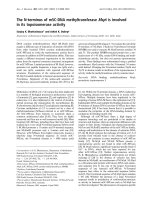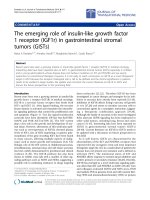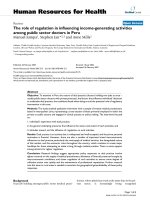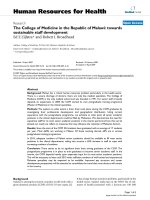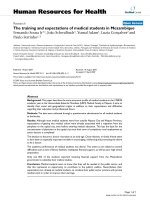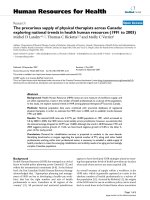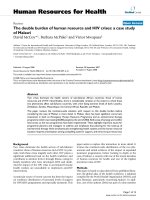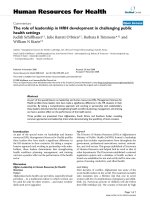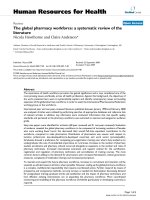báo cáo sinh học:" The precarious supply of physical therapists across Canada: exploring national trends in health human resources (1991 to 2005)" pptx
Bạn đang xem bản rút gọn của tài liệu. Xem và tải ngay bản đầy đủ của tài liệu tại đây (322.03 KB, 6 trang )
BioMed Central
Page 1 of 6
(page number not for citation purposes)
Human Resources for Health
Open Access
Research
The precarious supply of physical therapists across Canada:
exploring national trends in health human resources (1991 to 2005)
Michel D Landry*
1,2
, Thomas C Ricketts
2,3
and Molly C Verrier
1
Address:
1
Department of Physical Therapy, Faculty of Medicine, University of Toronto, Canada,
2
Department of Health Policy and Administration,
School of Public Health, University of North Carolina at Chapel Hill, USA and
3
Cecil G. Sheps Centre for Health Services Research, University of
North Carolina at Chapel Hill, USA
Email: Michel D Landry* - ; Thomas C Ricketts - ; Molly C Verrier -
* Corresponding author
Abstract
Background: Health Human Resource (HHR) ratios are one measure of workforce supply, and
are often expressed as a ratio in the number of health professionals to a sub-set of the population.
In this study, we explore national trends in HHR among physical therapists (PTs) across Canada.
Methods: National population data were combined with provincial databases of registered
physical therapists in order to estimate the HHR ratio in 2005, and to establish trends between
1991 and 2005.
Results: The national HHR ratio was 4.3 PTs per 10,000 population in 1991, which increased to
5.0 by 2000. In 2005, the HHR ratios varied widely across jurisdictions; however, we estimate that
the national average dropped to 4.8 PTs per 10,000. Although the trend in HHR between 1991 and
2005 suggests positive growth of 11.6%, we have found negative growth of 4.0% in the latter 5-
years of this study period.
Conclusion: Demand for rehabilitation services is projected to escalate in the next decade.
Identifying benchmarks or targets regarding the optimal number of PTs, along with other health
professionals working within inter professional teams, is necessary to establish a stable supply of
health providers to meet the emerging rehabilitation and mobility needs of an aging and increasingly
complex Canadian population.
Background
Health Human Resources (HHR) has emerged as a critical
factor in health policy planning across Canada [1-5], and
within the international community [6-8]. At the federal
level, the Pan-Canadian Health Human Resource Strategy
acknowledged that, "Appropriate planning and manage-
ment of HHR are key to developing a health-care work-
force that has the right number and mix of health
professionals to serve Canadians in all regions of the
country" [9]. All provincial and territorial jurisdictions
appear to have developed HHR strategies aimed at ensur-
ing that appropriate levels of health providers are in place
when and where services are most required [10].
An overall measure of supply within a workforce is the
HHR ratio, which is generally expressed as a ratio in the
absolute number of health professionals to a sub-set of
the population [11]. As noted by Ricketts [12], the origins
of the HHR ratio for use in workforce policy can be traced
back to work done in the United States where researchers
Published: 25 September 2007
Human Resources for Health 2007, 5:23 doi:10.1186/1478-4491-5-23
Received: 1 May 2007
Accepted: 25 September 2007
This article is available from: />© 2007 Landry et al; licensee BioMed Central Ltd.
This is an Open Access article distributed under the terms of the Creative Commons Attribution License ( />),
which permits unrestricted use, distribution, and reproduction in any medium, provided the original work is properly cited.
Human Resources for Health 2007, 5:23 />Page 2 of 6
(page number not for citation purposes)
in the 1930s identified a standard of 134.7 physicians per
100,000 (1:742) as a desirable target [13]. This crude
HHR ratio included all physicians, and the delineation
between primary care, sub-specialty, or even measures of
individual or group productivity, had not yet been consid-
ered within the estimate. Since that time, the HHR ratios
have become benchmarks to measure regional access to
health services, and as a method to identify or define an
under-serviced area.
In Canada, the published literature has estimated the sup-
ply of HHR for larger groups of professionals such as phy-
sicians [14-16] and nurses [17-19] across multiple time
periods. The literature describing these larger health disci-
plines is extensive; however very little is known about
smaller disciplines such as physical therapists (PTs) and
other rehabilitation providers. The emergence of a
national focus on inter-professional team practice within
primary care and public health initiatives has heightened
the need to more fully understand the human resource
composition within health care teams.
The Canadian Institute for Health Information (CIHI)
published a series of profiles of smaller health disciplines
such as audiologists, speech-language pathologists, occu-
pational therapists, and physical therapist [20]; however,
these reports did not account for the HHR ratios. The only
published study on HHR for PTs was conducted by Landry
[21] where the change in the HHR ratio across Canada
between 1991 and 2000 was documented. The estimated
national HHR ratio was 5.0 PTs per 10,000 population in
2000, which represented a 16.3% increased from
1991[21]. No other peer-reviewed sources concerning
physical therapy or other smaller health disciplines were
found; however the Canadian Association of Occupation
Therapists produced a commissioned report that outlined
the need to more fully understand HHR within their dis-
cipline [22].
In this current study, we follow up on the initial Landry
study [21], and explore trends regarding HHR ratios
among PTs in Canada. The purposes of this study were
threefold: first, to estimate the 2005 HHR ratio of PTs
across provincial jurisdictions by combining population
data with lists of registered PTs; second, to compare these
findings with those previously reported in order to
explore trends over the 15-year period from 1991 to 2005;
and third, to interpret the HHR trends from a health pol-
icy and workforce planning perspective.
Methods
The methodology used in this study was identical to the
one used by Landry [21]. Briefly, in order to estimate the
HHR ratio of PTs in Canada, two sources of data were
combined to generate estimates of the ratio of PTs to the
population. First, Canadian and provincial population
data were obtained from Statistics Canada [23]; and sec-
ond, the number of registered (active and inactive) PTs
was obtained from CIHI [20]. In order to develop a rela-
tive HHR indicator, these two data sources were trans-
formed into a ratio of the number of PTs per 10,000
population for the provinces and the country as a whole.
Territorial HHR ratios were not calculated due to lack of
valid data regarding the absolute numbers of PTs in the
Northwest Territories, Nunavut and Yukon during this
particular period. While we recognize that there are very
few PTs practicing in the territories, further research must
estimate HHR ratios and explore the degree to which the
supply of human resources is aligned with demand in
these sparsely populated but expansive jurisdictions.
Results
Population growth
The population of Canada was 32.6 million in 2005 rep-
resenting 19.5% growth from 1991, and a 5.9% growth
from 2000 [23]. Canada is predicted to experience a pop-
ulation growth of 14% between 2001 and 2021, and the
demographics of this growth will include a significant
increase in the proportion of the population over the age
of 65 years [24]. Though the population of the nation
continues to increase, positive growth is not necessarily
found across all jurisdictions.
As indicated in Table 1, the eastern-most province of New-
foundland and Labrador demonstrated a negative growth
pattern of 9.6% between 1991 and 2005. All other juris-
dictions had positive growth during the study period, led
by British Columbia (28.0%), Alberta (26.0%) and
Ontario (23.1%). However, growth rates in the latter part
of this 15-year period represent a different scenario. For
instance, in the 5-year period between 2000 and 2005, the
provinces of Newfoundland & Labrador, Prince Edward
Island, Nova Scotia, New Brunswick and Saskatchewan all
demonstrated negative growth ranging from 0.2% to
4.5%. Thus, although the 15-year period from 1991 to
2005 generally show a positive growth pattern in all juris-
dictions, trends in population growth in the latter 5 years
of this period shows slight negative growth in 5 of 10
provinces.
Growth in the absolute number of physical therapists
Similar to the overall Canadian population, the absolute
number of PTs also grew between 1991 and 2005. Accord-
ing to reports from the CIHI [20], the number of PTs
increased from 11,794 in 1991 to 15,772 in 2005, repre-
senting a 33.7% growth across the country. Similar to
population increase, growth of PTs is not equal across the
nation and there are important differences between prov-
inces (Table 2).
Human Resources for Health 2007, 5:23 />Page 3 of 6
(page number not for citation purposes)
As indicated in Table 2, although all ten provinces experi-
enced positive growth in the absolute numbers of PTs
from 1991 to 2005, the range was from a low of 17.9% in
Ontario, to a high of 78.3% in New Brunswick. However,
growth rates between 2000 and 2005 represent a different
scenario, and the provinces of Newfoundland & Labrador
and Ontario had negative growth of 0.5% and 3.1%
respectively.
Physical therapy health human resource (HHR) ratios
As reported previously, a measure of workforce supply
and density is the ratio in the absolute number of health
professionals to a sub-set of the population. In order to
explore trends over time, the HHR ratios of PTs per 10,000
population in each province were established for 2005,
and were then compared to previously reported estimates.
Figure 1 is a map of Canada showing the provincial ratios
of PTs to 10,000 population estimated at 3 points in time;
1991, 2000 and 2005.
The national average of PTs per 10,000 population was
4.3 in 1991, and 5.0 in 2000. In 2005, the ratio dropped
to 4.8. The trend in HHR ratio thus represents an 11.6%
growth between 1991 and 2005; however, the data also
show a negative growth trend of 4.0% between 2000 and
2005. The relative time period between these three data
points limits the degree to which fair and appropriate
comparisons can be made; for instance, there is a 10-year
period between 1991 and 2000; and a 5-year period
between 2000 and 2005. Nevertheless, the latter 5-year
period has shown a negative growth trend across Canada.
Figure 1 also outlines that the HHR ratios between 1991
and 2005 increased in almost all provinces. Additionally,
most provinces also experienced positive growth (albeit at
different rates) between 2000 and 2005. However, the
provinces of Ontario and British Columbia had decreased
HHR ratio between 2000 and 2005, and Alberta showed
no change in across the same 5-year period.
Table 1: Population by province, 1991–2005 [23]
Province 1991 (,000) 2000 (,000) 2005 (,000) Change (%)
1991–2000
Change (%)
2000–2005
Change (%)
1991–2005
Newfoundland and
Labrador
568.5 537.9 514.0 -5.4 -4.5 -9.6
Prince Edward
Island
129.8 138.3 138.0 +6.5 -0.2 +6.7
Nova Scotia 899.9 942.3 938.2 +4.7 -0.5 +4.3
New Brunswick 723.9 755.6 752.1 +4.4 -0.5 +3.9
Quebec 6,895.9 7,414.7 7,548.6 +7.5 +1.8 +9.5
Ontario 10,084.9 11,894.9 12,416.7 +17.9 +4.4 +23.1
Manitoba 1,091.9 1,149.1 1,170.0 +5.2 +1.8 +7.2
Saskatchewan 988.9 1,017.1 994.9 +2.6 -2.2 +0.6
Alberta 2,545.6 3,059.1 3,207.0 +20.2 +4.8 +26.0
British Columbia 3,282.0 4,101.6 4,203.3 +25.0 +2.5 +28.0
CANADA 27,296.8 30,790.8 32,623.5 +12.8 +5.9 +19.5
Table 2: Total number of physical therapists in Canada, 1991 to 2005 [20]
Province 1991 2000 2005 Change (%)
1991–2000
Change (%)
2000–2005
Change (%)
1991–2005
Newfoundland and
Labrador
121 199 198 +64.5 -0.5 +63.6
Prince Edward
Island
32 47 49 +46.9 +4.2 +53.1
Nova Scotia 341 453 529 +32.8 +16.7 +55.1
New Brunswick 240 411 428 +71.3 +4.1 +78.3
Quebec 2,427 3,370 3,677 +38.9 +9.1 +51.5
Ontario 4,509 5,486 5,314 +21.7 -3.1 +17.9
Manitoba 421 556 613 +32.0 +10.3 +45.6
Saskatchewan 337 527 534 +56.4 +1.3 +58.5
Alberta 1,408 1,829 1,924 +29.9 +5.2 +36.6
British Columbia 1,958 2,762 2,506 +41.1 +9.3 +27.9
CANADA 11,794 15,640 15,772 +32.6 +0.8 +33.7
Human Resources for Health 2007, 5:23 />Page 4 of 6
(page number not for citation purposes)
Change scores regarding population growth and physical
therapy HHR ratios
In order to more fully appreciate the association between
trends in overall provincial population growth and phys-
ical therapy HHR ratios over time, the change scores of
population growth and the change scores of the HHR
ratio of PTs to 10,000 population between 1991 and 2005
were plotted in Figure 2.
Figure 2 highlights wide variation between provinces. For
instance, Newfoundland & Labrador, the only province to
experience a negative population growth during the study
period, also showed the greatest change score in the ratio
of PTs to 10,000 population with a 85.7% increase
between 1991 and 2005. The majority of other provinces,
such as Prince Edward Island, Nova Scotia, New Bruns-
wick, Quebec, Manitoba, Saskatchewan and Alberta, expe-
rienced increased population growth (albeit at different
rates) along with a growth in the HHR ratio of PTs to pop-
ulation. However, in Ontario and British Columbia, pos-
itive population growth occurred alongside negative
growth in the HHR ratio. In Ontario, a population growth
of 23.1% occurred with a decrease in HHR ratio of 6.7%;
similarly a population growth of 27.9% in British Colum-
bia occurred along side a 1.7% decrease in HHR ratio.
Discussion
We have shown that trends in the HHR ratio of PTs to
population has increased by 11.6% between 1991 and
2005 (from 4.3 to 4.8 PTs per 10,000), but that the trend
Health human resource (HHR) ratio of physical therapists per 10,000 population across Canada: 1991, 2000 and 2005Figure 1
Health human resource (HHR) ratio of physical therapists per 10,000 population across Canada: 1991, 2000 and 2005.
Ontario
1991: 4.5
2000: 4.6
2005: 4.2
¨ 1991-2005: -6.7%˨
¨ 2000-2005: -8.7 %˨
Québec
1991: 3.5
2000: 4.5
2005: 4.8
¨ 1991-2005: 37.1%Ĺ
¨ 2000-2005: 6.7%
Ĺ
Manitoba
1991: 3.9
2000: 4.8
2005: 5.2
¨ 1991-2005: 33.3%Ĺ
¨ 2000-2005: 8.3%Ĺ
Alberta
1991: 5.5
2000: 6.0
2005: 6.0
¨ 1991-2005: 0.0%Ĺ
¨ 2000-2005: 0.0%
Saskatchewan
1991: 3.4
2000: 5.8
2005: 5.4
¨ 1991-2005:58.8%Ĺ
¨ 2000-2005: 3.8%
Ĺ
British Columbia
1991: 6.0
2000: 6.7
2005: 5.9
¨ 1991-2005: 1.7%p
¨ 2000-2005:11.9%p
Nova Scotia
1991: 3.8
2000: 4.8
2005: 5.6
¨ 1991-2005: 47.4%Ĺ
¨ 2000-2005: 16.7%
Ĺ
Newfoundland& Labrador
1991: 2.1
2000: 3.7
2005: 3.9
¨ 1991-2005: 85.7%Ĺ
¨ 2000-2005: 5.4%Ĺ
Prince Edward
Island
1991: 2.5
2000: 3.4
2005: 3.5
¨ 1991-2005: 40.0%Ĺ
¨ 2000-2005: 2.9%Ĺ
New Brunswick
1991: 3.3
2000: 5.4
2005: 5.6
¨ 1991-2005: 69.7%Ĺ
¨ 2000-2005: 3.7%
Ĺ
CANADA
1991: 4.3
2000: 5.0
2005: 4.8
¨ 1991-2005: 11.6%Ĺ
¨ 2000-2005: 4.0%p
Human Resources for Health 2007, 5:23 />Page 5 of 6
(page number not for citation purposes)
in the latter 5 years (between 2000 and 2005) showed a
decrease of 4.0% (from 5.0 to 4.8 PTs per 10,000). The
reason for this negative growth trend between 2000 and
2005 is not a function of decreasing number of PTs in
Canada – indeed, there were more PTs in 2005 than in any
other time period. Rather, the trend may partially be
explained by the fact that overall population growth
appears to be outstripping the growth in the number of
PTs across Canada, but especially in Ontario and British
Columbia where the greatest proportional population
growth occurred during the 15-year period between 1991
and 2005.
The reasons for the limited growth in HHR ratios of PTs in
relation to the population are not clear. When comparing
these trend data with those data reported by Landry [21],
it appears that all provinces other than Ontario and Brit-
ish Columbia have maintained a positive growth in HHR
of PTs to population. For instance, Landry reported that
Ontario and British Columbia had positive growth of
2.2% and 11.7% respectively; however, when compared
with estimates made in this study, HHR ratio have
decreased from 2.2 to -6.7 in Ontario, and from 11.7 to -
1.7 in British Columbia [21].
As mentioned previously, there were higher absolute
numbers of PTs in 2005 than in any previous time period.
There are thirteen university training programs across
Canada that educates PTs; the majority of these are
located in Ontario and Quebec. The five programs in
Ontario and the three in Quebec accounted for 65.6% of
all graduates in 2004. All thirteen of these educational
programs produced 665 PTs in 1995; but by 2004, these
programs dropped output by 34 students graduates [20].
Moreover, many of these educational programs have
shifted from a bachelor degree to a master entry-level to
practice degree during this period of time, which in turn
may have contributed to a lowered output of PTs. How-
ever, the output of PTs from these education programs
appears to have decreased while population growth has
increased, and possibly altering the balance between sup-
ply and demand for physical therapy services.
The implications and policy interpretation of these find-
ings are complex, and the data collected within this study
are not sufficient to establish causation. However critical
questions have emerged from this study related to the
optimal number of PTs in Canada; for instance, what is
the optimal supply of PTs to meet demand across Canada?
In other words, is the 2005 national average of 4.8 PTs per
10,000 "high", "low" or "just right"? To our knowledge,
there are no needs-based or evidence-based targets or
benchmarks regarding the number of PTs per population
across settings or conditions. In order to address the ques-
tion regarding optimal ratios, an analysis of supply and
demand for PT is necessary. Demand for health and reha-
bilitation services are projected to increase in the next dec-
ade [24,25]. However, factors that affect this demand have
not been fully explored. It is thus critical to develop a fore-
casting methodology that will estimate demand across
settings (i.e. hospital, home and community sectors) and
conditions (i.e. arthritis, and other chronic conditions).
Once demand for physical therapy services is established,
assessing the degree of alignment between supply and
demand will become more empirical.
Moreover, further examination of supply-side issues such
as individual and group productivity, relative attractive-
ness of certain sub-sectors for physical therapy practice,
episodic balance between the full-time and part-time
workforce, along with the emerging shifts form public to
private financing of services require in-depth analysis. As
supply and demand variables become established, work-
force policy and planning research will also become more
empirically based, and much less speculative.
Conclusion
The findings of this study signal a potential disequilib-
rium between supply and demand within the Canadian
physical therapy workforce; however further research is
A comparison of the change in population vs the change in the ratio of PTs to 10,000 population: 1991 to 2005Figure 2
A comparison of the change in population vs the change in
the ratio of PTs to 10,000 population: 1991 to 2005.
Legend:
Nfld & Lab=Newfoundland and Labrador
PEI=Prince Edward Island
NS=Nova Scotia
NB=New Brunswick
PQ=Quebec
ON=Ontario
MN=Manitoba
SK=Saskatchewan
AB=Alberta
BC=British Columbia
Legend:
Change in provincial population
Change in ratio of physical therapist to population
47.3%
11.6%
-1.7%
9.0%
58.8%
33.3%
-6.7%
37.1%
69.7%
40.0%
85.7%
-20
0
20
40
60
80
100
Province
Nfld &
Lab
PEI PQNBNS SKMN
ON
BC
AB CANADA
Publish with Bio Med Central and every
scientist can read your work free of charge
"BioMed Central will be the most significant development for
disseminating the results of biomedical research in our lifetime."
Sir Paul Nurse, Cancer Research UK
Your research papers will be:
available free of charge to the entire biomedical community
peer reviewed and published immediately upon acceptance
cited in PubMed and archived on PubMed Central
yours — you keep the copyright
Submit your manuscript here:
/>BioMedcentral
Human Resources for Health 2007, 5:23 />Page 6 of 6
(page number not for citation purposes)
necessary to forecast demand across settings and condi-
tions, and to explore the interaction of complex variables
that affect supply. The implication of forecasted popula-
tion growth, an aging population along with increasing
demand and wait times for health service delivery, will
require complex policy planning at multiple federal and
provincial levels of government. Our results highlight the
importance of further examining the precarious balance
between supply (i.e. human resources, financing) and
demand for health and rehabilitation services, and in
establishing targets regarding the optimum HHR ratios.
Developing such benchmarks is a first step to establishing
a stable supply of PTs which in turn will ensure that clients
have access to necessary services when and where they are
most needed.
Competing interests
The author(s) declare that they have no competing inter-
ests.
Authors' contributions
Michel D. Landry designed the study, participated in the
data collection, analyzed the data, and wrote successive
drafts of the manuscript. Thomas C. Ricketts and Molly C.
Verrier both participated in the design of the study, and
reviewed successive drafts of the manuscript. All authors
have read and approved the final manuscript.
Acknowledgements
The authors would like to acknowledge Dr. Victor W. Marshall, Professor
of Sociology and the Director of the Institute on Aging at the University of
North Carolina at Chapel Hill (UNC-CH), for his helpful comments and
edits. Dr. Michel D. Landry was a visiting scholar (funded through the
Toronto Rehabilitation Institute) at UNC-CH during this study, and is cur-
rently supported by a Career Scientist Award through the Ontario Ministry
of Health and Long Term Care (MOHLTC).
References
1. Collins-Nakai R, Adams O, Saulnier M: A Prescription for
Ontario's Wait Time Strategy. Healthcarepapers 2007,
7(1):46-50.
2. Sharp M: Enhancing Interdisciplinary Collaboration in Pri-
mary Health Care. Canadian Journal of Dietetic Practice & Research
2006:S4-8.
3. Smith ER: Cardiovascular Health Human Resources. Canadian
Journal of Cardiology 2006, 22(11):897-8.
4. Kondro W: Canada's Physician Density Remains Stagnant.
Canadian Medical Association Journal 2006, 175(5):465.
5. Baumann AO, Blythe JM, Underwood JM: Surge Capacity and Cas-
ualization: Human Resource Issues in the Post-SARS Health
System. Canadian Journal of Public Health 2006, 97(3):230-2.
6. Duffield C, Franks H: Career Paths Beyond Nursing and the
Contribution of Nursing Experience and Skills in Attaining
These Positions. Int J Nur Stud 2002, 39(6):601-609.
7. Zurn P, Dal Poz M, Stilwell B, Adams O: Imbalance in the Health
Workforce. Human Resources for Health 2004, 2:13.
8. Dreesch N, Dolea C, Dal Poz M, Goubarev A, Adams O, Aregawi M,
Bergstrom K, Fogstad H, Sheratt D, Linkins J, Scherpbier R, Youssef-
Fox M: An approach to estimating human resource require-
ments to achieve the Millennium Development Goals. Health
Policy and Planning 2005, 20(5):267-276.
9. Government of Canada. Health Human Resources Strategy
2006. Ottawa Ottawa 2006 [ />strateg/index_e.html]. Accessed on April 26, 2007
10. Government of Canada. Health Human Resources Action
Plan 2006 Ottawa 2005 [ />strateg/action-plan/index_e.html]. Accessed on April 26, 2007
11. Diallo K, Zurn P, Gupta N, DalPoz M: Monitoring and evaluation
of human resources for health: an international perspective.
Human Resources for Health 2003, 3(1):1-13.
12. Rickets T: (unpublished report) Developing Alternative
Approaches to Designating Underserved Populations. A
Focus on Professional-Population Ratios. Chapel Hill, NC: Cecil G. Sheps
Center for Health Services Research 2003.
13. Lee RI, Lewis WJ: The Fundamentals of Good Medical Care Chicago, Il:
The University of Chicago Press; 1933.
14. Stoddard GL, Barer M: Will Increased Medical School Entry
Solve Canada's Physician Supply Problem? Canadian Medical
Association Journal 1999, 161(8):983-984.
15. Yang H, Bryck R, Doren W: Analysis of Anesthesia Physician
Supply: Projected Deficits in 2005. Can J Anesthesia 2000,
47:179-184.
16. Tepper J: Evolving Role of Canada's Family Physicians, 1992–2001.
Toronto 2006 [ />Page.jsp?cw_page=AR_1171_E ]. Accessed on April 26, 2007
17. O'Brien-Pallas L, Baumann A, Donner G, Murphy GT, Luchass-Ger-
lash J, Luba M: Forecasting Models for Human Resources in
Health Care. Journal of Advanced Nursing 2001, 33(1):120-129.
18. Alameddine M, Laporte A, Baumann A, O'Brien-Pallas , Croxford R,
Mildon B, Wang S, Milburn B, Deber R: Where Are Nurses Work-
ing? Employment Patterns by Sub-sector in Ontario, Can-
ada. Healthcare Policy 2006, 1(3):65-86.
19. Canadian Institutes for Health Information: Workforce Trends of Regis-
tered Nurses in Canada, 2005. Ottawa 2005 [ />web/disp-
Page.jsp?cw_page=PG_590_E&cw_topic=590&cw_rel=AR_20_E ].
[Accessed on April 24, 2007]
20. Canadian Institutes for Health Information: Health Personnel trends in
Canada, 1995 to 2004. Ottawa 2004 [ />pPage.jsp?cw_page=AR_21_E]. [Accessed on April 24, 2007]
21. Landry MD: Physical Therapy Human Resources in Canada:
1991 to 2000. Physiotherapy Canada 2004, 56(1):39-42.
22. Parker-Taillon D: Background Paper on Occupational Therapy Human
Resource Data: Sources, Utilization, and Interpretative Capacity. Report
Prepared for the Canadian Association of Occupational Therapists. Toronto
2003 [t/ca/pdf/CAOTHReportMarch2003.pdf
].
[Accessed on February 7, 2007]
23. Statistics Canada: Population Estimates and Projections.
Ottawa 2007 [ />l3_3867_3433.htm?hili_demo23]. [Accessed on February 7, 2007]
24. Institute for Research and Innovation in Sustainability: The Sustain-
ability Report. Ottawa 2007 [
].
[Accessed on January 19, 2007]
25. Landry MD, Deber RB, Jaglal S, Laporte A, Holyoke P, Devitt R, Cott
C: Assessing the consequences of delisting publicly-funded
community-based physical therapy on self-reported Health
in Ontario, Canada: a prospective cohort study. International
Journal of Rehabilitation Research 2006, 29(4):303-307.
